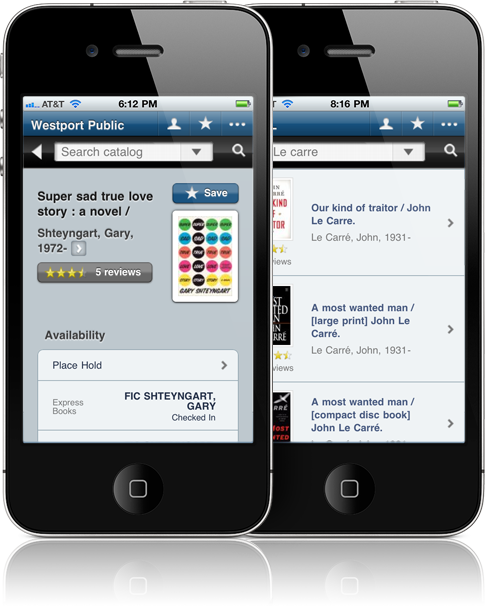
 We’re pleased to officially launch Library Anywhere. Library Anywhere is a mobile version of your public or academic library. It is available in mobile web formats today and in app forms in the coming weeks. It’s free for users, but libraries have to subscribe to it.
We’re pleased to officially launch Library Anywhere. Library Anywhere is a mobile version of your public or academic library. It is available in mobile web formats today and in app forms in the coming weeks. It’s free for users, but libraries have to subscribe to it.
Try it for yourself:
http://www.libanywhere.com
Or go directly into a library. Try Gwinnett County Public Library, University of Nebraska Omaha Library, or Waukegan Public Library as starting points.
Key features
- Search catalog, place holds, renew items. It does what the regular catalog does.
- Save records to your phone to access later. Works on any phone with a web-browsing feature—not just smart phones.
- “Universal Version” is fully compliant with Section 508 and other accessibility standards.
- Geo-location finds your nearest library easily.
- Libraries can display events, branches, contact-a-librarian information, and other mobile pages.
- LibraryThing for Libraries customers also get integrated tags, recommendations, information about other editions, and access to over 500,000 reviews.
- Costs far less than similar products.
- Works with most major OPAC systems.
Version 1.0 includes:
- iPhone mobile web
- Android mobile web
- Universal Version
Update!
The iPhone/iPad app is pending Apple approval, and will be released this month. Apps for other platforms will be released by the end of the year.
Customize your mobile presence. Library Anywhere features a fully customizable library home page. Add a logo, add links to your blog or Facebook page. Create pages within Library Anywhere as well, with your own content, such as book lists, announcements, and more. Add links to your existing “ask a librarian” features, too, like instant messaging or texting.
One catalog, many devices. Patrons don’t have to go looking for your mobile catalog, Library Anywhere comes to them. Library Anywhere can redirect mobile users of your OPAC to Library Anywhere. It will take the user to the version of Library Anywhere for their specific device—on an Android it will go to the Android version, on an iPhone it will go to the iPhone version, and any other device will be sent to the Universal Version. It will also invite users to check out the app, if there is one currently for their platform.
Library Anywhere is unique because it doesn’t just work on smart phones. Our Universal Version makes your library accessible to any device that can surf the web. The Universal Version can also be used as a fully Section 508 compliant version of your existing catalog.
Interested in adding your library to Library Anywhere?
To order Library Anywhere, or get a free trial, call 877 340-2400, or email Peder.Christensen@bowker.com. Bowker is the exclusive distributor of LibraryThing for Libraries.
You can also email questions to Abby@librarything.com.
Thanks to all. Many thanks to all of our numerous beta testers, who literally spent months playing with Library Anywhere, patiently finding bugs and waiting for us to fix them. Thank you for sticking with us!
“With the high level of functionality and the low pricing, this competition will lower the threshold for mobile technology into the reach of almost any library.”
Marshall Breeding, Smart Libraries Newsletter








 We’re happy to report that more than 40 libraries around the world have made their catalogs mobile with Library Anywhere since we launched last month. It’s a wide range of libraries, from small public libraries and school libraries to large universities and huge consortia of public libraries. And with over 100 more libraries in various stages of testing, we’re excited about Library Anywhere really taking off.
We’re happy to report that more than 40 libraries around the world have made their catalogs mobile with Library Anywhere since we launched last month. It’s a wide range of libraries, from small public libraries and school libraries to large universities and huge consortia of public libraries. And with over 100 more libraries in various stages of testing, we’re excited about Library Anywhere really taking off.


 We’re pleased to officially launch Library Anywhere. Library Anywhere is a mobile version of your public or academic library. It is available in mobile web formats today and in app forms in the coming weeks. It’s free for users, but libraries have to subscribe to it.
We’re pleased to officially launch Library Anywhere. Library Anywhere is a mobile version of your public or academic library. It is available in mobile web formats today and in app forms in the coming weeks. It’s free for users, but libraries have to subscribe to it.